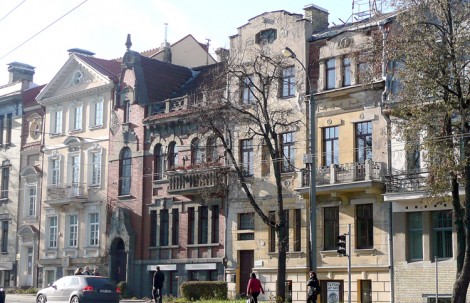- October 30, 2014
- 570
Roaming around the streets of Vilnius: Montwiłł – a great philanthropist

Not only one but more streets are named after him. Each name is different but they have one thing in common – Kolonia Montwiłłowska. This is the oldest housing association in Vilnius to which 22 townhouses with the addresses of J. Tumo-Vaižganto , J. Savickio oraz Kražių belong.
Here are some facts from the life of the patron of this place neighbouring with Lukiškės Square.
Józef Montwiłł (1850-1911) was born in Mitjaniszkach in wiłkomierski county in Lithuania. He finished The Faculty of Law at Saint Petersburg University. He studied also on universities in Berlin, Vienna and Cracow. He started to work as a director of Bank Ziemiański in Vilnius. Soon after he became a member of the administration of Bank Handlowy. He was also a town councillor in Vilnius. In 1897 Montwiłł was elected mayor but he was not approved by the czarist authorities.
He was known for his social and charitable involvement. He established “Biruta” Weaving School and “Lutnia” Artistic Society, he was one of the founders of the Agricultural Society of Vilnius, the Society of Friends of Sciences, the Museum of Science and Art Society, Girls Care Society, Child Care Society and Arranging Apartment Society. He was chairman of the City School Board for Care of the Poor and Supervisory Board of “Oświata” Polish Society. In 1907 Montwiłł was also a deputy to the III Duma.
He was the one to supervise building of new residence of Bank Ziemiański where present-day Bank of Lithuania is, on Giedymin avenue. The neighbouring building (present-day Giedymino 4) was residence for another Montwiłł’s project – Vilnian Craftsmen’s Fair. At Gedymin avenue 17 there was Józef Montwiłł’s palace. Nowadays there is a residence of Ministry of Telecommunications of Lithuania.
As far as architecture goes Józef Montwiłł is best known for building an estate of houses (Kolonia). He initiated building five such estates in Vilnius. The most famous is the one close to Łukiski square.
The passage of time is merely visible here. The modernistic townhouses could be said to be cut out from an old album. All of them have separate entrance. Some of them have small gardens. It is very quiet here although it is the city center.
The project to build Montwiłłowska Estate was announced between 1912-1913. That was the time when Józef Montwiłł took care of three gifted Vilnian architects: Wacław Michniewicz, Władysław Stypulkowski i August Klein. Apart from private buildings they also built founding hospitals, market Pod Halą and a powerhouse where nowadays museum of energetics is. Michniewicz was one of the authors of the estate project. He was a city architec’s assistant. He supervised building of the city waterspouts and new streets, as well as organizing riverfront of Vilia or building of the iron bridge on Wilenka (Antokol). Monwiłł renovated the theatre in Towns Hall, St. Theresa Church and St. Jacob and St. Philip Church. The house in Tumo-Važzganto 4/1 street belonged to Michniewicz. He lived here with his family between 1913-1915
Stefan Narębski lived in one of the townhouses in J. Savickio street. In 1928 he was nominated for the position of the city architect in Vilnius. He had lectures on monuments conservation at Fine Arts Department USB, he was also interior designer. In 1937 he became a USB associate professor. In 1945 he left for Torun where he was one of the organizers of the Mikołaj Kopernik University Fine Arts Department.
Józef Montwiłł was buried in Rossa cementary. Only after four years (17th may 1914) was a headstone put up on his grave – an angel carrying the torch of learning. It was designed by Zygmunt Józef Otto (1874 -1944) and cost 7 thousand roubles which was quite a big sum of money at that time. In 1932 the people of Vilnius built a monument for Józefowi Montwiłł made by Bolesław Bałzukiewicz. It can be admired in square close to the Franciscan church, in Trakų street. In 1989 the Polish Culture in Lithuania Fund (Fundacja Kultury Polskiej na Litwie im. Józefa Montwiłła) has adtoped Montwiłł as its patron.
Translated by Gabriela Godek within the framework of a traineeship programme of the European Foundation of Human Rights, www.efhr.eu.

